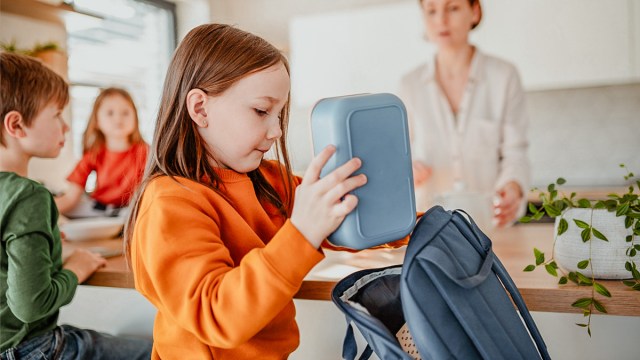If you’re a parent, you know the discouraging feeling of opening your kiddo’s lunchbox after school only to find everything uneaten and exactly where you left it. Not only is it beyond frustrating, but you’ve spent time preparing their lunch—sacrificing precious Netflix hours, thank you very much!—and now you’re left with wasted food and the guilt of wondering if your kid was running around hungry all day.
As a pediatric dietitian and mom of three, I’ve been there many times. It’s maddening, but it’s also super common. So, let’s break down why those lunches are coming home untouched and, more importantly, what we can do to turn things around.
5 reasons school lunches come home uneaten and what you can do about it
1. They’re full of snacks
Sometimes kids don’t eat lunch because they’re still full from snack time. Schools have limited time for breaks and recess is often scheduled too close to lunchtime. If your child’s lunchbox looks like it’s untouched, it might be because they had a satiating snack earlier and simply weren’t hungry.
Solution: Pack fewer snacks or add another meal
One option is adjusting snack portions. You can either pack smaller snacks or reduce the quantity so your kiddo has room in their tummy for lunch. The other option is adding an after-school meal. If they’re still skipping lunch despite fewer snacks, a substantial after-school snack will make up for their missed school lunch.
Focus on nutrient-dense foods like Greek yogurt, hard-boiled eggs, or cheese, which are high in protein and satiating fat. You might need to push dinner back an hour or two and slightly adjust bedtime, but remember, this doesn’t have to be a permanent change. It’s a temporary solution during periods when their lunch is regularly uneaten.
2. They’re not fans of what’s packed
School lunches aren’t the time to experiment with new or unfamiliar foods. If your child has a consistent pattern of rejecting the same meals or foods, chances are they simply don’t like what’s packed or are hesitant to try it.
Solution: Involve your kids in packing lunches
Getting kiddos involved in packing their lunches gives them a sense of control, which may make them more excited to eat it. They’ll also only pack foods they enjoy eating.
Here’s how to make it work:
- Give clear guidelines, like one sandwich, one fruit, and one veggie. This keeps their choices balanced and prevents them from packing chocolate chip cookie sandwiches and candy salads!
- Bring your kids along to the grocery store and allow them to choose what they want for their lunches. This can also expand their food preferences as they explore different options.
3. The food doesn’t look enticing or is the wrong temperature
There’s a chance your child doesn’t want to eat their lunch because, well, it just looks gross. Like adults, kids are drawn to food that looks appealing. If their lunch gets squished from bouncing around in their backpack, it probably doesn’t look appetizing. Similarly, food that’s too cold and congealed or too warm and mushy loses its appeal, and your child is less likely to eat it.
Solution: Invest in quality lunch gear
Investing in the right lunch gear can make a big difference. Here are a few items to consider:
- Temperature-controlled containers: A thermos or insulated lunchbox can keep food at the right temperature–cool in summer and warm in winter.
- Sturdy lunchboxes: Look for a lunch or bento box with tight lids to prevent food from shifting around and getting squished.
- Mini containers: Use small containers for dips, dressings, or messy foods to keep them separate and prevent them from ruining the rest of the meal.
4. They’re distracted and overwhelmed
School cafeterias can be loud, chaotic, and feel like sensory overload. With all the conversations, smells, and the hustle and bustle, it can be tough for some kids to focus on eating. For those who don’t do well in overstimulating environments, the anxiety or discomfort might cause them to skip their lunch altogether.
Solution: Pack a simple lunch
Pack a simple, visually underwhelming lunch. Skip the bento box or container with multiple compartments and stick to basics, like a brown paper bag with just a sandwich and a piece of fruit. This can reduce distractions and the mental load of too many choices and give them the space to focus on eating.
It’s also important to talk to the teacher or principal to see if there’s a quiet corner where your child (and a few friends!) can eat lunch without the overwhelming noise and chaos. It may not work logistically, but it’s worth asking.
5. They’re tired of the same foods
I don’t know about you, but when my kid’s lunch box comes home empty, I tend to pack the same lunch the next day because I know they like it and will eat it. While this works for some kids who are happy to take the same exact meal every day for months, others get bored and start rejecting their lunches.
Solution: Make small tweaks
Like I said, lunch time isn’t the time to experiment with completely new recipes, but you can switch things up with the foods you know they already like. For example, if they love cheese sandwiches, try mixing it up with a grilled cheese or a cheese quesadilla. Changing the form of a familiar food can make it feel new and exciting without introducing unfamiliar flavors.
Most importantly, don’t shame your kids for not eating their lunch or pressure them to eat it. The key is to have a conversation coming from a place of curiosity, not judgment. Toddlers and younger kids might not be able to explain why they didn’t eat their lunch, but you can gently ask questions to get a better sense of what happened. Ask things like, “Who did you sit next to at lunch?” or “I wonder what your friend Sam ate today.” These conversation starters can give you clues and help you understand what’s going on.
For older kids, have a more direct conversation and ask them what you can do to help them better enjoy their lunch. This way, you can tailor their lunches to their preferences while also creating a safe space where they don’t feel judged for not eating.











